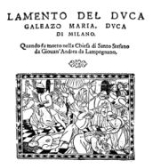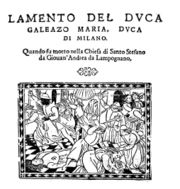
Giovanni Andrea Lampugnani
Encyclopedia
Giovanni Andrea Lampugnani (died 26 December 1476) was a member of the Milan
ese nobility and an assassin of Galeazzo Maria Sforza
, the Duke of Milan.
The Lampugnani family was a high-ranking family in Renaissance
Milan, and Giovanni served in several government positions, often working quite closely with the Duke. Under the Duke, Giovanni's brothers leased some valuable land from a rural abbey
. Upon the death of the abbot, the inheriting cleric nullified the lease and evicted the Lampugnani brothers from the property. Although the family appealed to the Duke, there was no government intervention on the matter, resulting in utter contempt on the part of Giovanni.
The Duke, although popular as a patron of the arts, was known to be rather ruthless in his rule and something of a womaniser, traits which encouraged more enemies to emerge amongst the government ranks. Two other officials, Carlos Visconti
and Gerolamo Olgiati
soon joined Giovanni in a conspiracy to assassinate the Duke.
 Despite evidence that plotting may have begun as early as 1474, there was little planning on the conspirators' part beyond the actual assassination; no efforts were made to find further outside support amongst any ruling families, nor were getaway plans solidified.
Despite evidence that plotting may have begun as early as 1474, there was little planning on the conspirators' part beyond the actual assassination; no efforts were made to find further outside support amongst any ruling families, nor were getaway plans solidified.
Giovanni, the leader of the plot, gathered with the other conspirators in the church of Santo Stefano on December 26, 1476 (the day of the martyr, Santo Stefano) to prepare for the assassination. Armed and wearing hidden armour, they convened before Mass in the morning, praying for the saint's protection.
When the Duke's procession arrived, Giovanni, Visconti and Olgiati stepped before the Duke, Giovanni going down on one knee. After a brief exchange of words, Lampugnani rose suddenly, stabbing the Duke in the groin and chest. Soon he was joined by Visconti, Olgiati and a servant of Lampugnani's named Franzone
, stabbing the Duke to death.
Pandemonium erupted quickly, as the congregation — assassins included — fled the church. Giovanni, in an attempt to escape, ran to the women's side of the church where he was subsequently caught and killed. His head was severed and, with the heads of other assassins (who were all apprehended and executed within a week) displayed on the belltower as a warning for several years following.
In the days immediately following the Duke's assassination, other Lampugnani family members were arrested on suspicion of compliance and much of their property destroyed by mobs. Most of the remaining Lampugnani fled Milan or was exiled to other cities.
Milan
Milan is the second-largest city in Italy and the capital city of the region of Lombardy and of the province of Milan. The city proper has a population of about 1.3 million, while its urban area, roughly coinciding with its administrative province and the bordering Province of Monza and Brianza ,...
ese nobility and an assassin of Galeazzo Maria Sforza
Galeazzo Maria Sforza
Galeazzo Maria Sforza was Duke of Milan from 1466 until his death. He was famous for being lustful, cruel and tyrannical....
, the Duke of Milan.
The Lampugnani family was a high-ranking family in Renaissance
Italian Renaissance
The Italian Renaissance began the opening phase of the Renaissance, a period of great cultural change and achievement in Europe that spanned the period from the end of the 13th century to about 1600, marking the transition between Medieval and Early Modern Europe...
Milan, and Giovanni served in several government positions, often working quite closely with the Duke. Under the Duke, Giovanni's brothers leased some valuable land from a rural abbey
Abbey
An abbey is a Catholic monastery or convent, under the authority of an Abbot or an Abbess, who serves as the spiritual father or mother of the community.The term can also refer to an establishment which has long ceased to function as an abbey,...
. Upon the death of the abbot, the inheriting cleric nullified the lease and evicted the Lampugnani brothers from the property. Although the family appealed to the Duke, there was no government intervention on the matter, resulting in utter contempt on the part of Giovanni.
The Duke, although popular as a patron of the arts, was known to be rather ruthless in his rule and something of a womaniser, traits which encouraged more enemies to emerge amongst the government ranks. Two other officials, Carlos Visconti
Carlos Visconti
Carlo Visconti was a member of the prominent Visconti family, a government secretary in Milan's Council of Justice, and an assassin of Galeazzo Maria Sforza, the Duke of Milan....
and Gerolamo Olgiati
Gerolamo Olgiati
Gerolamo Olgiati was a government official in Milan and one of the assassins of Galeazzo Maria Sforza, the Duke of Milan, along with Giovanni Andrea Lampugnani and Carlo Visconti....
soon joined Giovanni in a conspiracy to assassinate the Duke.
Assassin

Giovanni, the leader of the plot, gathered with the other conspirators in the church of Santo Stefano on December 26, 1476 (the day of the martyr, Santo Stefano) to prepare for the assassination. Armed and wearing hidden armour, they convened before Mass in the morning, praying for the saint's protection.
When the Duke's procession arrived, Giovanni, Visconti and Olgiati stepped before the Duke, Giovanni going down on one knee. After a brief exchange of words, Lampugnani rose suddenly, stabbing the Duke in the groin and chest. Soon he was joined by Visconti, Olgiati and a servant of Lampugnani's named Franzone
Franzone
Franzone was a servant of the Lampugnani family of Milan, and a figure in the assassination of Galeazzo Maria Sforza, the Duke of Milan....
, stabbing the Duke to death.
Pandemonium erupted quickly, as the congregation — assassins included — fled the church. Giovanni, in an attempt to escape, ran to the women's side of the church where he was subsequently caught and killed. His head was severed and, with the heads of other assassins (who were all apprehended and executed within a week) displayed on the belltower as a warning for several years following.
In the days immediately following the Duke's assassination, other Lampugnani family members were arrested on suspicion of compliance and much of their property destroyed by mobs. Most of the remaining Lampugnani fled Milan or was exiled to other cities.

